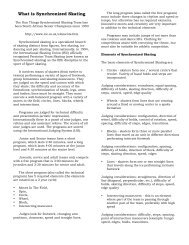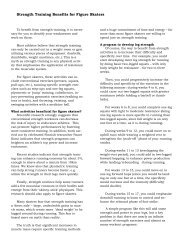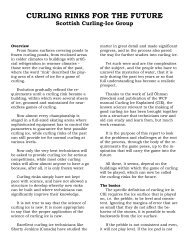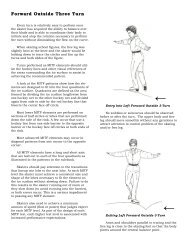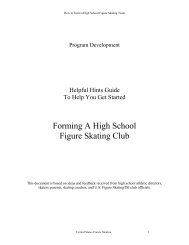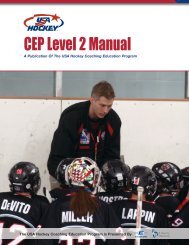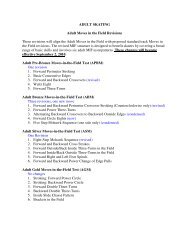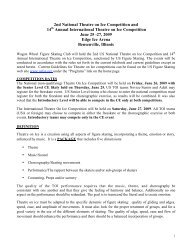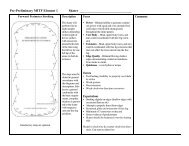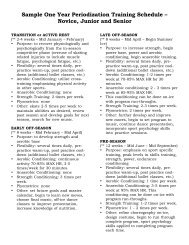CEP Level 3 Manual - Rushmore Hockey Association
CEP Level 3 Manual - Rushmore Hockey Association
CEP Level 3 Manual - Rushmore Hockey Association
You also want an ePaper? Increase the reach of your titles
YUMPU automatically turns print PDFs into web optimized ePapers that Google loves.
T A B L E O F C O N T E N T SW2D2CD1W1Normally the wings stay in their lanes.However, if a wing moves to another lane, severaloptions exist. (See Figure 4)1. The center moves to fill the wing’s lane2. The defenseman on that side moves to fill thewing’s lane3. The puck carrier moves the puck to a playerfilling an outside laneIf the center is the puck carrier and the wingsare behind the play, the center then has thefollowing options (See Figure 6 a-d).LWCD1D2RWLWFigure 6d. Wings breaking toward theblue line.SCRWFigure 2. Offense in the neutral zone.The situation illustrated in Figure 2 is usuallyreferred to as three-on-two. Moving the puck to W2provides the opportunity to create a two-on-one andforces D1 to make a decision: Does he want to stayone-on-one with W1 or should he move over to helpD2 and thus leave that area open? Even if W1 iscovered by a backchecking forward, D1 will wonderabout leaving the area open. In this case, D1 willhave to ask the question, “Can I really trust thebackchecker to defend the area alone?”By isolating defensive players in a two-on-onesituation, you put tremendous pressure on themmentally and physically. This creates anopportunity for them, and their teammates to makemental errors and therefore, provide offensiveopportunities for your team.While following the basic premise of entering theoffensive zone near the boards, provide someflexibility by allowing your players to change lanes.This creates many options. Some of the morecommon ones are lane changes illustrated in Figure 3.LWLDCRDRWLWFigure 4.Lane change options when a wingmoves to another lane.When the center is the puck carrier and has oneor both wings ahead of the play, the puck should bepassed to either wing who stays in his/her lane ormoves to the middle lane. Teach the center to reactto the wing’s movement. The puck-side defensemanhas the option to fill a lane or remain at his position.These options are illustrated in Figure 5.LWFigure 5.LDCLDCRDRDRWLane change options when thewings are ahead of the center.RWFigure 6a.Hold the puck.a. Hold the puck and set up a two-on-onesituation against a defenseman (D2). In thissituation the wings must break.Figure 6b. Swing wide and carry the puck.b. Swing wide and carry the puck deep alongthe boards with the wing (LW) following.This creates a two-on-one situation on adefenseman (D1) in a vertical alignment.LWLWCD1D1CFigure 6c. Cut to the boards.c. Cut to the boards. The wing (LW) cuts to themiddle creating a two-on-one situation on adefenseman (D1).d. Slows down or stops close to the blue linepermitting the wings to break toward theblue line and receive a pass or be in positionto gain possession of the puck if it is passedin to the corner.Defenseman should never keep the puck andforce their forwards to stop skating. Theirresponsibility is to move the puck and keep the playmoving toward the offensive zone. The forwardscan move up the ice or move to another lane. Theseoptions are illustrated in Figure 7.LWFigure 7.Defensemen options to keep theforwards skating.Defensemen can also work a give-and-go asillustrated in Figure 8. The defenseman (LD) passesto a wing (LW) and moves up to receive a returnpass. They will create a two-on-one situation on thedefensemen (D1) for the LD and the Center.D1LDCCRDRWFigure 3. Player lane change options.LWCLDFigure 8.A defenseman initiated give-and-go.178 | USA <strong>Hockey</strong> Coaching Education Program <strong>Level</strong> 3 <strong>Manual</strong>Offensive Team Tactics | 179



